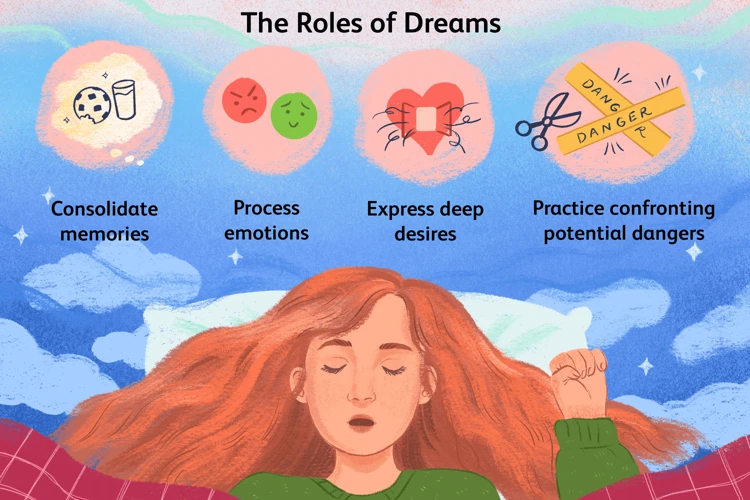Imagine constantly being stuck in the same dream, experiencing the same events over and over again. It’s a puzzling phenomenon that many people have encountered – recurring dream patterns. These elusive dreams can feel like a never-ending loop, leaving us pondering their meaning and significance. In this article, we will delve into the depths of recurring dreams, exploring their definition, common themes, and the implications they hold for our psychological well-being. We will uncover effective strategies to break these recurring dream patterns and offer tips on implementing changes in daily life to promote better sleep and overall mental health. So, if you’re ready to unravel the mysteries of your dreams and make positive transformations, read on.
Understanding Recurring Dream Patterns

Recurring dream patterns refer to a phenomenon where individuals experience the same dream or a similar dream scenario repeatedly over a period of time. These dreams often possess a consistent theme, storyline, or imagery, creating a sense of familiarity and repetition in the dreamer’s subconscious mind. While the frequency and duration of these recurring dreams may vary, their presence can be perplexing and raise questions about their underlying meaning and purpose.
Recurring dreams can manifest in a multitude of themes that are unique to each individual’s subconscious mind. However, certain recurring dream themes tend to be more prevalent. These include:
- Falling: The sensation of falling from a great height is a common recurring dream theme. It often symbolizes a lack of control or fear of failure in waking life.
- Being Chased: Many people experience recurring dreams where they are being pursued or chased by an unseen force or a specific person. This theme typically represents avoidance or unresolved conflicts in one’s life.
- Exam or Test Anxiety: Students or individuals who have experienced academic pressure may have recurring dreams related to exams or tests. These dreams often manifest anxiety and feelings of being unprepared.
- Unpreparedness: Dreams revolving around being unprepared for an important event, such as a presentation or performance, highlight feelings of vulnerability and apprehension.
- Nakedness: Dreams where individuals find themselves naked in public symbolize vulnerability, self-esteem issues, or a fear of being judged or exposed.
It’s important to note that these themes may have different interpretations based on an individual’s personal experiences and emotions.
1. Definition of Recurring Dream Patterns
The definition of recurring dream patterns refers to the phenomenon where individuals experience the same dream or a similar dream scenario repeatedly over a period of time. These dreams often possess a consistent theme, storyline, or imagery, creating a sense of familiarity and repetition in the dreamer’s subconscious mind. The recurrence of these dreams can vary in frequency, ranging from occasional repeats to more frequent occurrences. Recurring dreams can occur over weeks, months, or even years, leaving individuals puzzled about their significance and purpose. They can be vivid and detailed, leaving a lasting impression on the dreamer.
Understanding the definition of recurring dream patterns is crucial when exploring their implications and the impact they can have on our psychological well-being. While there is no universally agreed-upon explanation for why recurring dreams occur, they provide valuable insights into our subconscious mind and can serve as a window into our inner thoughts, emotions, and unresolved conflicts. By examining the recurring themes and elements of these dreams, we can start to unravel the deeper meaning and messages hidden within our subconscious.
For more information on the psychological interpretation of recurring dream patterns, you can refer to our previous article “The Role of Recurring Dreams: Psychological Interpretation”. This article explores the various theories and perspectives on the psychological aspects of recurring dreams. It dives into the symbolism and potential connections between these dreams and our waking life experiences.
2. Common Themes in Recurring Dreams
When exploring common themes in recurring dreams, it is important to recognize that these themes can vary from person to person. Despite this, there are several recurring dream themes that tend to be universally experienced. One of these common themes is falling, where individuals dream of plummeting from a great height. This recurring dream often signifies a lack of control or a fear of failure in one’s waking life. Another prevalent theme is being chased, where dreamers find themselves pursued or chased by an unknown entity or someone specific. This theme often represents avoidance or unresolved conflicts in one’s life. Additionally, many individuals experience recurring dreams related to exam or test anxiety, particularly those who have experienced academic pressure. These dreams tend to manifest anxiety and feelings of being unprepared or overwhelmed.
Other common recurring dream themes include feelings of unpreparedness for an important event, such as a presentation or performance. These dreams highlight vulnerability and apprehension. Lastly, dreams involving nakedness where individuals find themselves exposed in public often symbolize vulnerability, self-esteem issues, or a fear of judgment or exposure.
Understanding the significance of these common themes in recurring dreams can provide valuable insights into one’s subconscious mind and emotions. By exploring the interpretation of these themes, individuals can gain a deeper understanding of their own thoughts and feelings, leading to personal growth and self-awareness.
Implications of Recurring Dream Patterns

Implications of recurring dream patterns extend beyond mere curiosity and can provide valuable insights into an individual’s psychological and emotional well-being. These dreams offer a window into the subconscious mind, revealing hidden fears, unresolved conflicts, and unresolved emotions. By analyzing and interpreting these recurring dreams, individuals can gain a deeper understanding of themselves and their inner struggles.
In terms of emotional significance, recurring dreams can be indicators of underlying stress, anxiety, or trauma. They serve as a way for the subconscious mind to process and release intense emotions that may be suppressed during waking hours. The emotions experienced within these dreams can mirror and represent the individual’s emotional state in real life, providing an opportunity for self-reflection and emotional healing.
Recurring dream patterns offer insights into the subconscious mind and its functioning. They can reveal patterns of thought, ingrained beliefs, and deep-rooted fears that may not be immediately apparent in waking life. Through careful analysis, individuals can identify recurring symbols and motifs within their dreams, uncovering patterns that may have shaped their behavior and thought processes.
Understanding the implications of recurring dream patterns can lead to personal growth, the resolution of deep-seated issues, and improved mental well-being. It is essential to pay attention to these dreams and explore their significance to foster self-awareness and a greater understanding of oneself.
1. Psychological Interpretation
Diving into the psychological interpretation of recurring dream patterns reveals valuable insights into the inner workings of the subconscious mind. These dreams can serve as a window into our deepest thoughts, desires, and fears, offering a glimpse into our emotional and psychological well-being.
Psychologists suggest that recurring dreams often reflect unresolved issues or internal conflicts that we may be experiencing in our waking lives. These dreams can act as a symbolic representation of the subconscious mind’s attempt to process and make sense of these unresolved issues.
For example, recurring dreams of falling may indicate a fear of failure or a lack of control in our waking life situations. The symbolism of being chased could signify avoidance of confronting certain emotions or situations that we find uncomfortable or threatening.
Additionally, recurring dreams can also be a result of repressed memories or traumatic experiences. These dreams may serve as a means for the subconscious mind to bring these unresolved traumas to the surface, facilitating the healing process and promoting emotional growth.
Understanding the psychological interpretation of recurring dreams can empower individuals to explore their inner thoughts and emotions, aiding in self-reflection and personal development. By delving into the significance of these dreams and seeking professional guidance if needed, individuals can gain a better understanding of themselves and work towards resolving underlying psychological issues.[1]
2. Emotional Significance
Recurring dream patterns hold emotional significance as they often reflect the inner emotional state and unresolved issues of the dreamer. These dreams can evoke intense emotions such as fear, anxiety, sadness, or excitement. By examining the emotions experienced during recurring dreams, individuals can gain valuable insights into their subconscious feelings and emotions.
Recurring nightmares, a specific type of recurring dream, have a particularly strong emotional impact. These vivid and distressing dreams can cause significant emotional distress and interfere with sleep quality. The emotional intensity of recurring nightmares can be indicative of underlying psychological issues or unresolved trauma. Understanding the connection between recurring nightmares and mental health is crucial in addressing any potential psychological issues that may be contributing to the dream patterns.
Recurring dreams with positive emotions, such as joy, love, or contentment, can offer clues about unfulfilled desires, aspirations, or areas of happiness in one’s life. These dreams may serve as a reminder to pay attention to those aspects and incorporate them into daily life.
3. Insights into Subconscious Mind
Our recurring dreams can offer valuable insights into our subconscious mind. These dreams provide a window into our deepest thoughts, desires, and fears that may not be fully acknowledged or explored in our waking life. Here are some intriguing aspects and potential revelations that recurring dreams can offer:
- Unresolved Issues: Recurring dreams often highlight unresolved conflicts or issues that are lingering in our subconscious. These dreams may nudge us to address these unresolved matters in our waking life, allowing us to find closure and inner peace.
- Emotional Clues: Our recurring dreams can reveal underlying emotions that we may be suppressing or ignoring. These dreams act as a mirror, reflecting our true emotional state and signaling areas of our life that require attention and nurturing.
- Past Traumas: Recurring dreams sometimes revolve around past traumatic experiences that have not been fully processed or healed. These dreams can serve as invitations to dive into our past, seek therapeutic support, and embark on a journey of healing and growth.
- Subconscious Desires: Our recurring dreams may offer glimpses into our deepest desires and ambitions, even those we may not consciously recognize. These dreams can serve as a catalyst for exploring our true passions and pursuing a more fulfilling life.
- Symbolic Representations: Recurring dream patterns often utilize symbolism to convey messages or insights. By deciphering the symbols present in these dreams, we can gain a better understanding of our subconscious mind’s language and the meanings behind our dreams.
By paying close attention to the recurring dreams we experience, we can unlock a wealth of information about ourselves, our emotions, and our life’s direction. Keeping a dream journal and reflecting on the themes, emotions, and symbols present in our recurring dreams can help us decode their messages and gain valuable insights into our subconscious mind.
Breaking Recurring Dream Patterns

Dream Journaling: Keeping a dream journal is a powerful tool for breaking recurring dream patterns. By recording your dreams as soon as you wake up, you can identify patterns, symbols, and emotions that occur frequently in your dreams. This awareness helps you gain insight into the underlying issues that may be causing the recurring dreams.
Identifying Triggers and Stressors: Paying attention to your waking life can provide clues about the triggers and stressors that contribute to your recurring dreams. Examine your daily routines, relationships, and emotional state to identify any patterns or sources of stress that may be influencing your dream content. Once identified, you can take steps to address these issues and reduce their impact on your dreams.
Visualization and Affirmations: Utilizing visualization and affirmations can help break recurring dream patterns by rewiring your subconscious mind. Before going to bed, visualize yourself having a peaceful and positive dream experience. Repeat affirmations such as “I am in control of my dreams” or “My dreams are filled with joy and serenity.” These practices can help shift your subconscious beliefs and create new dream patterns.
Lucid Dreaming Techniques: Lucid dreaming is the practice of becoming aware that you are dreaming while still in the dream state. By developing lucid dreaming skills, you can actively influence and change the outcomes of your dreams. Techniques such as reality checks, dream journaling, and setting intentions before sleep can increase your chances of achieving lucidity in your dreams and breaking the cycle of recurring dream patterns.
Seeking Professional Help: If recurring dreams are causing significant distress or interfering with your daily life, it may be beneficial to seek professional help. Psychologists, therapists, or dream specialists can provide guidance and support in understanding and resolving recurring dream patterns. They can help you explore deeper psychological meanings and develop strategies specific to your individual needs.
1. Dream Journaling
Dream journaling is a powerful tool for understanding and analyzing recurring dream patterns. By regularly recording your dreams in a journal or diary, you can gain insights into the recurring themes, symbols, and emotions that appear in your dreams. Here’s how to effectively incorporate dream journaling into your routine:
- Keep a journal by your bedside: Place a journal and a pen or pencil next to your bed. This will make it easy for you to record your dreams as soon as you wake up, before they fade from memory.
- Record details: Write down as many details as possible about your dreams, including the setting, characters, events, and emotions you experienced. Be specific and descriptive.
- Look for patterns: Review your dream journal regularly and identify any recurring themes, symbols, or emotions that appear in your dreams. Pay attention to any changes or patterns that emerge over time.
- Reflect on possible meanings: Take some time to reflect on the potential meanings of your dreams. Consider how they relate to your waking life, emotions, and experiences. Seek resources like books or online articles for guidance in dream interpretation.
By consistently engaging in dream journaling, you can gain a deeper understanding of your recurring dream patterns and potentially uncover valuable insights into your subconscious mind and inner thoughts.
2. Identifying Triggers and Stressors
Identifying triggers and stressors is an essential step in breaking recurring dream patterns. By recognizing the factors that contribute to these dreams, individuals can gain insight into their underlying causes and work towards resolving them. Here are some strategies to help identify triggers and stressors:
- Keeping a dream journal: Maintaining a dream journal can aid in identifying patterns and common elements among recurring dreams. Recording dreams immediately upon waking can capture important details and emotions, allowing for a better understanding of potential triggers.
- Reflecting on daily experiences: Reflecting on daily experiences and events can reveal stressors that may be influencing our dreams. Paying attention to significant occurrences, conflicts, or unresolved issues can provide valuable clues to the triggers of recurring dreams.
- Exploring emotions: Emotions experienced within recurring dreams can be indicators of underlying stressors in waking life. Examining the feelings evoked during these dreams can help pinpoint specific areas of stress or discomfort.
- Seeking professional guidance: In some cases, professional help from psychologists or dream analysts may be beneficial in identifying triggers and stressors. These experts can provide guidance in interpreting recurring dreams and help uncover the hidden meanings behind them.
By diligently practicing these strategies, individuals can gain a clearer understanding of the triggers and stressors that contribute to their recurring dreams and take necessary steps to address them.
3. Visualization and Affirmations
Visualization and affirmations are powerful techniques that can help break recurring dream patterns and reprogram the subconscious mind. By using the power of imagination and positive statements, individuals can create a shift in their dream experiences. Here’s how you can utilize visualization and affirmations to bring about change:
- Create a clear vision: Spend a few minutes each day visualizing yourself in a dream scenario where you break free from the recurring pattern. Clearly imagine yourself taking control, overcoming obstacles, and experiencing a new and positive outcome.
- Repeat affirmations: Choose affirmations that directly address the specific recurring dream pattern you wish to change. For example, if you often dream of being chased, you can use affirmations such as “I am safe and protected in all areas of my life” or “I release my fears and embrace freedom.” Repeat these affirmations daily, preferably in front of a mirror or while in a relaxed state.
- Engage your emotions: As you visualize and repeat affirmations, try to evoke positive emotions that align with your desired dream outcome. Feel the joy, peace, and empowerment of breaking free from the recurring pattern. The more emotionally connected you are to the visualization and affirmations, the more impactful they will be.
- Consistency is key: Make visualization and affirmations a regular part of your routine. Dedicate a specific time each day to practice these techniques, as consistency is crucial for creating lasting change in your dream patterns.
By incorporating visualization and affirmations into your daily life, you can reprogram your subconscious mind and break free from the repetitive cycle of recurring dreams.
4. Lucid Dreaming Techniques
Lucid dreaming techniques can be a powerful tool for breaking recurring dream patterns. Lucid dreaming refers to the state of being aware that you are dreaming while you are still in the dream. This awareness allows you to have some degree of control over the dream narrative and actions, which can help interrupt and alter recurring dream patterns. Here are a few techniques to enhance your lucid dreaming abilities:
- Reality checks: Perform reality checks throughout your waking hours to develop a habit of questioning whether you are dreaming or not. Common reality checks include looking at your hands, trying to push your finger through your palm, or checking if text or numbers change when you look away and then back again.
- Mindfulness meditation: Regular practice of mindfulness meditation can enhance your self-awareness and increase the chances of becoming lucid in your dreams. It helps with developing mindfulness during waking hours, which can carry over into your dreams as well.
- Visualize lucidity: Before going to bed, spend a few minutes visualizing yourself becoming lucid in your dreams. Imagine recognizing dream signs, gaining control over the dream, and exploring the dream world with full awareness.
- Reality testing within dreams: While you are dreaming, employ reality testing techniques to trigger lucidity. For example, question your surroundings, try to change the environment, or focus on specific dream signs that indicate you are dreaming.
- Keep a dream journal: Maintaining a dream journal can help you become more familiar with the patterns and themes in your dreams, making it easier to recognize when you are in a dream state. Write down your dreams immediately upon waking, and look for recurring elements that can serve as cues for becoming lucid.
By incorporating these lucid dreaming techniques into your routine, you can increase the likelihood of experiencing lucidity during your dreams, leading to potential breakthroughs in breaking recurring dream patterns.








